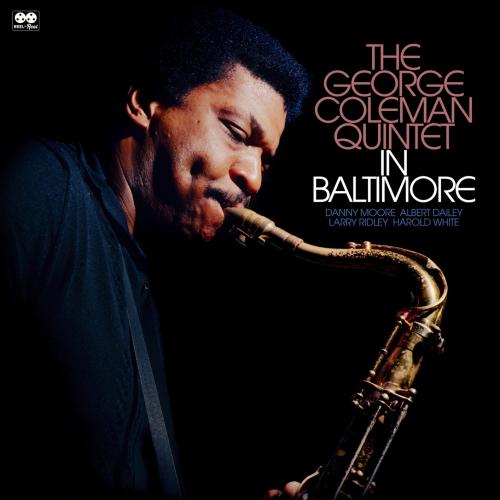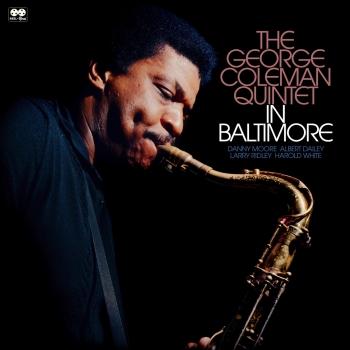
The George Colman Quintet in Baltimore (Remastered) George Coleman Quintet
Album Info
Album Veröffentlichung:
2020
HRA-Veröffentlichung:
11.12.2020
Das Album enthält Albumcover
- 1 Afternoon in Paris (Live) 11:49
- 2 Sandu (Live) 10:26
- 3 I Got Rhythm (Live) 05:13
- 4 Body & Soul (Live) 09:55
- 5 Joy Spring (Live) 09:29
Info zu The George Colman Quintet in Baltimore (Remastered)
One of jazz’s most powerful tenor saxophonists is heard at his freewheeling, unfettered best on The George Coleman Quintet in Baltimore, a hitherto unheard live recording due from Reel to Real Recordings as an exclusive. The high-energy set, captured at the Famous Ballroom in Baltimore on May 23, 1971, by engineer Vernon Welsh for the Left Bank Jazz Society, and restored for Reel to Real by Chris Gestrin.
The set marks the second project from the Left Bank—which mounted live jazz shows in Baltimore from 1964 through the ‘90s—to be unearthed by Resonance Records co-president and noted “Jazz Detective” Zev Feldman, who is partnered in Reel to Real with Vancouver-based jazz impresario and saxophonist Cory Weeds. Reel to Real previously issued A Soulful Sunday by vocalist Etta Jones featuring the Cedar Walton Trio.
Now 85, Coleman was the product of the fertile jazz scene in Memphis, which produced such renowned contemporaries as Charles Lloyd, Phineas Newborn, Jr., Frank Strozier, Booker Little, Hank Crawford, and the tenorist’s longtime band mate Harold Mabern. From the early ‘60s, he was a noted sideman, perhaps best known for his 1963-64 stint with Miles Davis’ “second great quintet,” which included Herbie Hancock, Ron Carter, and Tony Williams. He also made notable records with Hancock (the classic Maiden Voyage), Lee Morgan, Chet Baker, Jimmy Smith, Charles Mingus, and Max Roach, among others.
Coleman cut his first studio album as a leader in 1977; he played and recorded regularly with Mabern until the keyboardist’s death in 2019. Reel to Real’s new release represents the saxophonist’s earliest available live offering fronting a nonpareil combo of his own.
He is joined by trumpeter Danny Moore (whose credits include work with Quincy Jones, Count Basie, Oliver Nelson, Buddy Rich, and Dizzy Gillespie), pianist Albert Dailey (Sonny Rollins, Stan Getz, Hank Mobley, Kenny Dorham, Art Blakey), bassist Larry Ridley (Horace Silver, Jackie McLean, Philly Joe Jones, Randy Weston, Barry Harris), and drummer Harold White (Gary Bartz, Rahsaan Roland Kirk, Eddie Jefferson).
“This is one hell of a band,” jazz historian and archivist Michael Cuscuna notes in his comprehensive overview of the date. “This concert is a rare early glimpse at George Coleman in charge and, as always, playing magnificently.”
In a new interview with Weeds included in the set, Coleman looks back at his days at the venue that was a regular hitching post for him in the ‘70s.
“Oh yeah, the Famous Ballroom was great,” Coleman says. “We used to get up there quite a bit, with Wynton Kelly, Ron McClure and Jimmy Cobb. Those were some of the good moments. I really enjoyed playing there. The people were nice, too. A lot of black folks used to go there, too. It was integrated—I mean, black, white, whatever. They were there to listen to the music. It was a really great era.”
Feldman, who selected the ’71 Famous Ballroom set from a trove of Left Bank recordings, says, “Cory and I have total reverence for Coleman and we wanted to roll out the red carpet for him on this very special production….George Coleman is someone who is extremely important in this music. Now that he's in the twilight of his career, it's nothing short of a blessing to be able to present this music for the very first time.”
Weeds, who has himself presented the tenor player at his Vancouver club the Cellar, says of the Baltimore date, “Coleman is playing with reckless abandon, not concerned with perfection or even precision. He is clearly feeding off the energy of the crowd and riding high above the beautiful accompaniment from the top-flight rhythm section. He is going for it. The no-holds-barred approach that is his signature is on full display throughout this whole date, and it’s absolutely delightful.”
Heatedly charging through Clifford Brown’s compositions “Sandu” and “Joy Spring,” John Lewis’ “Afternoon in Paris,” and puissant readings of “I Got Rhythm” and “Body and Soul,” Coleman ably demonstrates that he remains one of the most underestimated soloists in jazz.
Neatly summing up the collection in an interview with Weeds, the band leader’s student and self-defined disciple Eric Alexander succinctly sums up The George Coleman Quintet in Baltimore: “It’s about the music and the music is f___ing great.”
George Coleman, tenor saxophone
Danny Moore, trumpet
Albert Dailey, piano
Larry Ridley, bass
Harold White, drums
Recorded Live on May 23, 1971 at The Famous Ballroom in Baltimore, MD
Digitally remastered
George Edward Coleman
(born March 8, 1935) is an American jazz saxophonist known for his work with Miles Davis and Herbie Hancock in the 1960s. In 2015, he was named an NEA Jazz Master.
Coleman was born in Memphis, Tennessee. He was taught how to play the alto saxophone in his teens by his older brother Lucian Adams, inspired (like many jazz musicians of his generation) by Charlie Parker. Among his schoolmates were Harold Mabern, Booker Little, Frank Strozier, Hank Crawford, and Charles Lloyd.
After working with Ray Charles, Coleman started working with B.B. King in 1953, at which point he switched to tenor saxophone.[4] In 1956 Coleman moved to Chicago, along with Booker Little, where he worked with Gene Ammons and Johnny Griffin before joining Max Roach's quintet (1958–1959). Coleman recorded with organist Jimmy Smith on his album Houseparty (1957), along with Lee Morgan, Curtis Fuller, Kenny Burrell, and Donald Bailey. Moving to New York City with Max Roach in that year, he went on to play with Slide Hampton (1959–1962), Ron Carter, Jimmy Cobb, and Wild Bill Davis (1962), before joining Miles Davis' quintet in 1963–1964.
His albums with Davis (and the rhythm section of Herbie Hancock (piano), Ron Carter (bass), and Tony Williams (drums)) are Seven Steps to Heaven (1963), A Rare Home Town Appearance (1963), Côte Blues (1963), In Europe (1963), My Funny Valentine, and Four & More, both live recordings of a concert in Lincoln Center for the Performing Arts in New York City in February 1964. Shortly after this concert, Coleman was replaced by Wayne Shorter. Nevertheless, Davis retained a high opinion of Coleman's playing, stating that "George played everything almost perfectly...He was a hell of a musician." Coleman played with Lionel Hampton (1965–1966), also in 1965 on Chet Baker's The Prestige Sessions, with Kirk Lightsey, Herman Wright, and Roy Brooks.[6] Clark Terry, Horace Silver, Elvin Jones (1968), Shirley Scott (1972), Cedar Walton (1975), Charles Mingus (1977–1978), Ahmad Jamal (1994, 2000), and many others.
Coleman also appeared in the science-fiction film Freejack (1992), starring Emilio Estevez, Mick Jagger, and Anthony Hopkins; and 1996's The Preacher's Wife, with Denzel Washington and Whitney Houston.
Coleman recorded into the 2000s. His CD as co-leader, Four Generations of Miles: A Live Tribute To Miles, with bassist Ron Carter, drummer Jimmy Cobb and guitarist Mike Stern was released on Chesky Records in October 2002, and it concentrates almost exclusively on the 1950s repertoire of Miles Davis. Tracks include: "There Is No Greater Love", "All Blues", "On Green Dolphin Street", "Blue in Green", "81", "Freddie Freeloader", "My Funny Valentine", "If I Were a Bell", and "Oleo". He was featured on Joey DeFrancesco's 2006 release Organic Vibes, along with vibraphonist Bobby Hutcherson, Billboard's Top Jazz Album Chart, peaked to No. 17.
Coleman was married to jazz organist Gloria Coleman and is father to jazz drummer George Coleman Jr.
He was named an NEA Jazz Master and to the Memphis Music Hall of Fame in 2015, and received a brass note on the Beale Street Brass Notes Walk of Fame.
Dieses Album enthält kein Booklet









